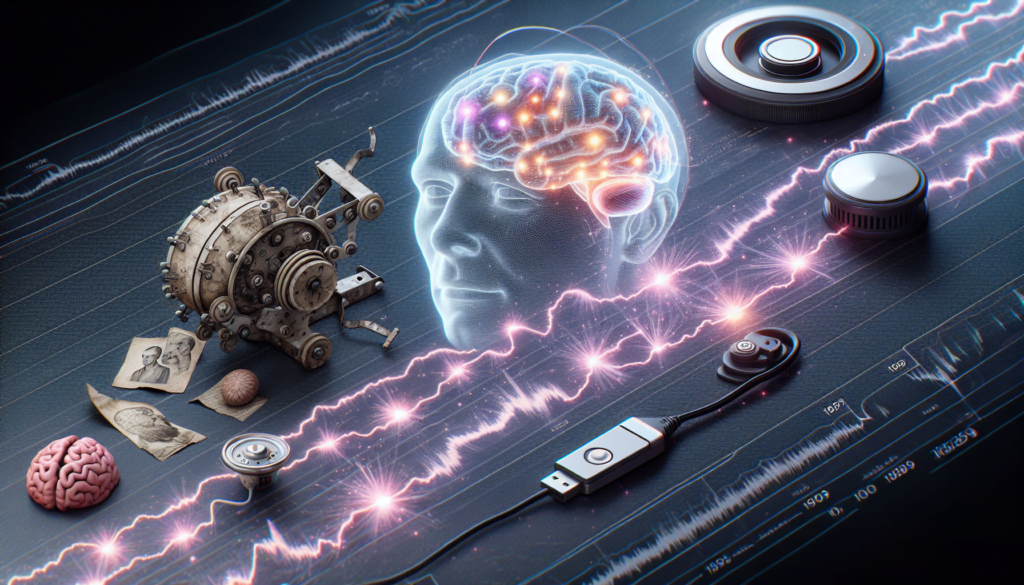Neurofeedback, a fascinating intersection of neuroscience and technology, has evolved from a scientific curiosity to a respected therapeutic modality. Its history is a tapestry of discovery and innovation, revealing the brain’s remarkable ability to change and adapt. Understanding the origins and development of neurofeedback not only sheds light on its current applications but also underscores why it remains a topic of interest for researchers, clinicians, and individuals seeking alternative approaches to mental health.
Key Takeaways
- Neurofeedback has its roots in the early 20th century with the invention of the electroencephalogram (EEG).
- Pioneers like Hans Berger, Joe Kamiya, and Barry Sterman played crucial roles in the development of neurofeedback.
- The technique gained traction in the 1960s and 1970s, with applications expanding in subsequent decades.
- Technological advancements have made neurofeedback more accessible and user-friendly.
- Current research continues to explore neurofeedback’s efficacy for various disorders, with promising trends for the future.
Introduction to Neurofeedback
Definition of Neurofeedback
Neurofeedback, also known as EEG biofeedback, is a therapeutic intervention that trains individuals to alter their brain activity. It involves monitoring brain waves and providing real-time feedback to help individuals learn to regulate their own neural patterns.
Brief Overview of Its Development
The development of neurofeedback has been a journey of more than a century, beginning with the discovery of the brain’s electrical nature and culminating in the sophisticated, computer-based systems used today. This evolution has been marked by key discoveries and technological breakthroughs, each contributing to the understanding and enhancement of brain function.

Early Discoveries and Hans Berger’s Contribution
The Invention of the Electroencephalogram (EEG)
The story of neurofeedback begins with the invention of the EEG in the early 20th century. This device, which records electrical activity in the brain, laid the groundwork for all subsequent neurofeedback research and practice.
Hans Berger’s Discovery of Brain’s Electrical Activity
Hans Berger, a German psychiatrist, was instrumental in demonstrating that the brain produces electrical activity that can be recorded and analyzed. His pioneering work in the 1920s with the EEG provided the first glimpse into the brain’s electrical patterns, a discovery that would eventually lead to the development of neurofeedback (source).

The Emergence of Neurofeedback in the 1960s
Joe Kamiya and Alpha Brain Waves
Experiments at the University of California, San Francisco
In the 1960s, neurofeedback began to take shape as a distinct field when psychologist Joe Kamiya conducted experiments at the University of California, San Francisco. Kamiya discovered that individuals could learn to control their alpha brain waves when provided with feedback, a finding that sparked interest in the potential of self-regulation of brain activity.
The Concept of Brain Wave Control with Feedback
Kamiya’s work demonstrated that feedback could be a powerful tool in teaching individuals to influence their own brain waves, laying the foundation for neurofeedback therapy (source).
Barry Sterman’s Research and Its Impact
Sensory Motor Rhythm (SMR) Brain Waves in Cats
Another significant contributor to the field was Barry Sterman, who, through his work with cats, identified the sensory motor rhythm (SMR), a specific pattern of brain waves. Sterman’s research showed that training these brain waves could have a calming effect on the nervous system.
Implications for Epilepsy Treatment
Sterman’s subsequent research with humans suggested that SMR training could reduce seizure frequency in individuals with epilepsy, providing a new avenue for treatment and further validating the therapeutic potential of neurofeedback (source).

Expansion of Neurofeedback in the 1970s and 1980s
Broader Clinical Applications
Attention Deficit Hyperactivity Disorder (ADHD)
During the 1970s and 1980s, neurofeedback began to be explored for a wider range of clinical applications. One of the most notable was its use in treating ADHD, where it showed promise in helping to improve concentration and reduce impulsivity.
Anxiety Disorders
Neurofeedback also began to be used for anxiety disorders, with some individuals experiencing relief from symptoms through brain wave training.
Substance Abuse
Additionally, neurofeedback was investigated as a potential treatment for substance abuse, with some studies indicating it could help reduce cravings and prevent relapse.
Key Figures and Their Contributions
Joel Lubar’s Clinical Research
One key figure during this time was Joel Lubar, whose clinical research into neurofeedback and ADHD provided important insights into the technique’s efficacy and helped to establish protocols still in use today (source).

Technological Advancements and Popularity in the 1990s
Improvements in Neurofeedback Equipment
The 1990s saw significant improvements in neurofeedback equipment, with the development of more sophisticated and precise systems. This allowed for better monitoring and feedback, making the therapy more effective.
Increased Accessibility and User-Friendliness
Advancements in technology also made neurofeedback more accessible and user-friendly, enabling its use in a wider variety of settings, including clinics, research institutions, and even at home.
Growth in Clinical Use and Research
As a result of these advancements, the 1990s experienced a growth in both clinical use and research into neurofeedback, solidifying its place as a legitimate therapeutic option for various conditions.
Neurofeedback in the 21st Century
Integration of Advanced Computational Methods
In the 21st century, neurofeedback has benefited from the integration of advanced computational methods, such as machine learning and real-time data analysis, which have enhanced the precision and customization of training protocols.
Exploration of Efficacy for Various Disorders
Neurological Disorders
Current research continues to explore the efficacy of neurofeedback for a range of neurological disorders, including epilepsy, stroke rehabilitation, and traumatic brain injury.
Psychological Disorders
Neurofeedback is also being studied for its potential benefits in treating psychological disorders, such as depression, anxiety, and PTSD, with some studies showing promising results (source).
Current Trends and Future Directions in Neurofeedback Research
The field of neurofeedback is now characterized by a focus on evidence-based practice and a continued exploration of its applications. Researchers are investigating its use for conditions like autism spectrum disorders and its potential to enhance cognitive performance in healthy individuals. The future of neurofeedback holds the promise of further discoveries and a deeper understanding of the brain’s capacity for change (source).
Neurofeedback’s journey from a scientific curiosity to a therapeutic tool reflects the broader evolution of our understanding of the brain. As technology and neuroscience continue to advance, neurofeedback stands as a testament to the human pursuit of knowledge and the potential to harness the brain’s own abilities for healing and growth.
Curious Minds Want to Know: The Neurofeedback Journey – An FAQ Exploration
What is neurofeedback and how does it work?
Neurofeedback, also known as EEG biofeedback, is a therapeutic intervention that provides immediate feedback from a computer-based program that assesses a person’s brainwave activity. The program then uses sound or visual signals to retrain or reorganize these brain signals. By responding to this feedback, individuals can learn to regulate their own brain activity to improve various cognitive, emotional, and physical functions.
Who discovered neurofeedback and when?
Neurofeedback has roots in the 1920s with the discovery of the electroencephalogram (EEG), but it wasn’t until the 1960s that neurofeedback began to develop as a therapy. Dr. Joe Kamiya is credited with the discovery of neurofeedback at the University of Chicago, when he demonstrated that individuals could learn to control their alpha brain waves when provided with feedback.
How has neurofeedback evolved over time?
Neurofeedback has evolved significantly since its inception. Initially, it was primarily used for research and experimental purposes. Over time, advances in technology and a deeper understanding of brain function have allowed neurofeedback to become more sophisticated and accessible. It’s now used to treat a wide range of conditions, including ADHD, anxiety, depression, and sleep disorders.
What was the role of the EEG in the development of neurofeedback?
The EEG was instrumental in the development of neurofeedback. It allowed scientists and clinicians to observe and measure brainwave patterns, which are the basis for neurofeedback training. The ability to monitor brain activity in real time provided the necessary feedback loop for individuals to learn how to alter their brainwaves consciously.
What are some of the scientific principles behind neurofeedback?
Neurofeedback is grounded in principles of operant conditioning, a type of learning where behaviors are increased or decreased through reinforcement or punishment. In neurofeedback, desirable brainwave patterns are reinforced while undesirable patterns are not, leading to changes in brain activity. Additionally, neuroplasticity, the brain’s ability to reorganize itself by forming new neural connections, is a key principle that allows for the changes brought about by neurofeedback to endure.
What conditions is neurofeedback commonly used to treat?
Neurofeedback is used to treat a variety of conditions, including attention-deficit/hyperactivity disorder (ADHD), anxiety, depression, epilepsy, insomnia, and traumatic brain injuries. It is also used to enhance performance in areas such as sports, music, and academics.
Is neurofeedback considered a mainstream medical treatment?
Neurofeedback is not universally considered a mainstream medical treatment, but it has gained recognition and acceptance in certain medical and psychological communities. Its efficacy is supported by a growing body of research, though it is often recommended as a complementary therapy rather than a primary treatment modality.
What are the potential risks or side effects of neurofeedback?
Neurofeedback is generally considered safe with minimal risks. Some individuals may experience temporary side effects such as fatigue, headache, or anxiety as their brain adjusts to the training. However, these side effects are typically mild and resolve on their own. It is important to undergo neurofeedback training with a qualified practitioner to minimize any potential risks.
Can neurofeedback be used for enhancing cognitive performance in healthy individuals?
Yes, neurofeedback is not only used for treating disorders but also for cognitive enhancement in healthy individuals. It can improve focus, reduce stress, and enhance various cognitive functions. Athletes, musicians, and business professionals are among those who use neurofeedback to gain a competitive edge in their respective fields.
How accessible is neurofeedback therapy to the general public?
The accessibility of neurofeedback therapy has improved with technological advancements and increased availability of practitioners. However, it can still be relatively expensive and is not always covered by insurance. Some clinics offer sliding scale fees, and home neurofeedback systems have become more available, though professional guidance is recommended for best results.



